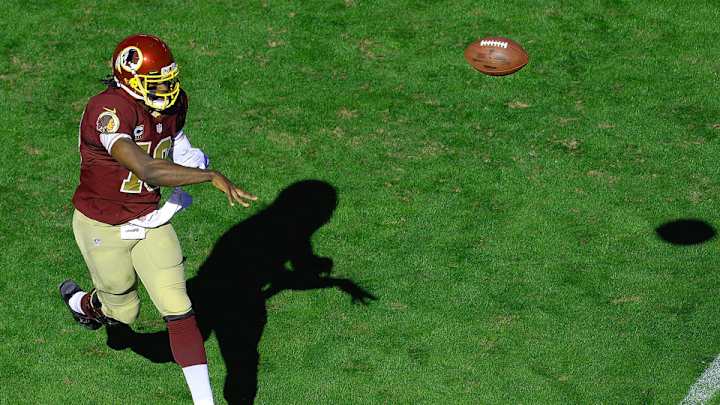The Trouble with RG3

Robert Griffin III was the NFL’s most talked about player entering the season, and the conversation surrounding him hasn’t waned over the first nine weeks. Much of it has been conjecture and pontification, which is the nature of football’s media coverage. As a result, some important points have been lost along the way.
There’s no question that RG3’s surgically repaired right knee has significantly impacted his game. His trust in the knee seems to fluctuate, and it's no surprise that his running prowess has declined. Through the first half of the 2012 season, he had 24 scrambles for an average gain of 12.0 yards. According to Football Outsiders, he also averaged 4.8 yards on 40 “other runs” such as read-options, draws and bootlegs. So far this season, Griffin has scrambled 18 times for an average of 5.7 yards. He’s averaging 5.9 yards on “other” runs, but those attempts are down 30%. It’s clear that he lacks the same burst and change-of-direction quickness that defined his rookie season.
Griffin has also been cautious with his knee when dropping back to pass. Though he is stepping into his throws with more conviction than he did back in September, his footwork remains inconsistent and has led to accuracy glitches, with too many of his balls sailing high.
These issues aren’t great secrets.
If he can't flourish as a pocket passer, hits like these will eventually catch up with Robert Griffin III. (Patrick Semansky/AP)
Less noticed, but more important, is his failure to grasp the cerebral elements of his position. Because his otherworldly athleticism has diminished, Griffin is now operating from the pocket more often. Every great NFL quarterback (with the possible exception of Ben Roethlisberger) has a refined pocket presence. Griffin, at this point, does not.
This should be alarming to Washington, because it factors into the amount (and severity) of hits RG3 takes. Last season Griffin absorbed many big hits at the end of scrambles. He scrambled because he was a one-read quarterback, meaning he tucked the ball and ran if his initial receiver wasn’t open. Though he remains mostly a one-read QB in Washington’s run-based system, Griffin has been given more multi-progression play designs by head coach Mike Shanahan and offensive coordinator Kyle Shanahan. (It’s been a must because Washington has played from behind more than any team except for Jacksonville.)
Griffin’s growth has been sluggish here. To be fair, he’s only 23 and he spent the entire offseason rehabbing his knee. And the process isn’t as simple as the Shanahans saying, “On these next few plays, if Option A is covered, we want you to stay in the pocket and look for Option B instead of scrambling, and if he’s covered, go to Option C.” Staying in the pocket requires fine-tuned mechanics. It also requires the quarterback to actually understand what he’s looking at.
Inexperienced quarterbacks often think that reading the field means recognizing when a guy gets open. Great QBs know that reading the field is more about recognizing when a guy is not open. Quickness is the key to good recognition. Great quarterbacks have a scientific understanding of how each route works in relation to the others, and how they’re all designed to leverage different defensive looks and find holes in the coverage.
After diagnosing the defensive scheme, a great quarterback knows almost immediately what his best options are. Instead of waiting to see if Option A, B or C eventually gets open, he treats those reads as quick confirmations (maybe a defender has slipped?) before targeting Options D and E. This is how QBs like Tom Brady, Peyton Manning and Drew Brees are able to work deep into their progressions, and why they’re so tough to stop.
An unrefined quarterback sits in the pocket and waits ... and waits ... and waits ... for Option A to get open. Or, when he finally moves on to Option B, he starts the mental process all over again. He treats Options A, B and C as separate entities, not realizing that the specific way in which Option A is covered often reveals everything he needs to know about B and C. By waiting too long on Option A, the window for hitting B or C—exploited spaces that are often built into the play design—can open and close without the quarterback ever seeing it.
Halfway through his second season, Griffin is unmistakably an unrefined quarterback. He is unable to consistently anticipate whether receivers are going to be open or covered. He tends to fixate on his initial read, which leads to trouble.
There were several illustrations of this in Washington’s Week 8 loss at Denver, where Griffin was hit (often viciously) on half of his drop-backs. Several of those hits, including the two plays broken down below, were enabled by his poor pocket presence and his inability to make multiple downfield reads.
The only thing worse than taking an unnecessary hit is taking such a hit while failing to see a wide open touchdown. Take a look at the play below:
